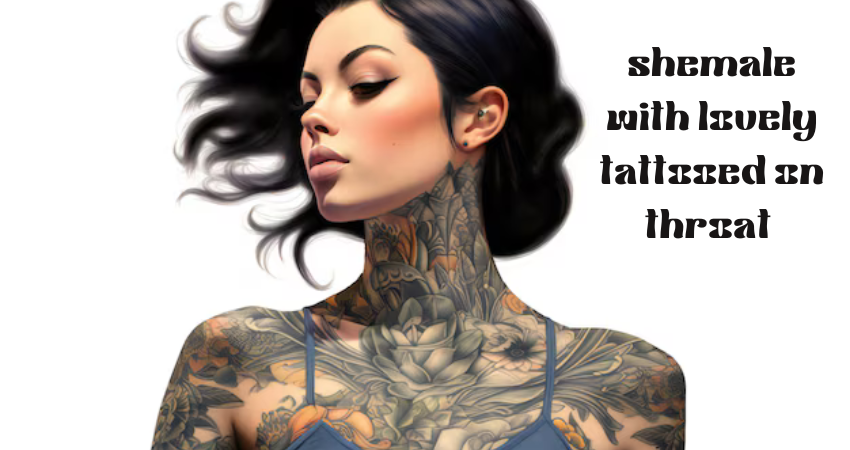The history of gender non-conformity is as old as human civilization. Within this broad spectrum, the concept of “shemale with lovely tattooed on throat ” has evolved, reflecting changing social attitudes and diverse expressions of identity. This article explores the unique story of shemales with throat tattoos, particularly those featuring the word “Lovely.” Beyond mere decoration, tattoos have historically served as profound symbols of self-expression, defiance, and empowerment. The “Lovely” throat tattoo stands as an emblem of individuality and a testament to the resilience of those who choose to define their own narratives.
Origins of the Term Shemale
The term “shemale with lovely tattooed on throat ” has a complex and controversial history. It originated as a slang term in the 20th century, often used in a derogatory context. Initially, it described transgender women or individuals who straddled conventional gender norms. As awareness grew, the word became a topic of debate within the LGBTQ+ community. While some reclaimed the term as a form of empowerment, others viewed it as a relic of outdated perceptions.
Historical Linguistics: The roots of the term stem from blending gendered language, highlighting societal discomfort with ambiguity.
First Recorded Uses: Early appearances in pulp fiction and underground zines during the mid-1900s reflect its role in counterculture movements.

The Evolution of Shemale Culture
Throughout the 20th century, representations of shemales shifted alongside broader societal changes. The community faced numerous challenges, from ostracization to misrepresentation, but also found platforms for celebration and recognition.
20th Century Representation: Characters in underground cinema and literature began showcasing the diversity of gender identities.
Activism and Change: Grassroots campaigns and prominent figures helped dismantle stereotypes, paving the way for more nuanced portrayals.
Tattoos as an Expression of Identity
Tattoos hold a special place in the history of marginalized communities. Among shemales, tattoos symbolize self-ownership and resistance against societal norms.
Symbolism: Throat tattoos, in particular, are seen as a declaration of strength.
Visibility: Being one of the most prominent areas of the body, the throat tattoo makes an unapologetic statement.
“Lovely” Tattoo: Meaning and Significance
Why the word “Lovely”? For many, it represents an affirmation of their worth in a world that often fails to see their beauty. The placement on the throat—a vulnerable yet powerful location—emphasizes this statement.
Personal Narratives: Numerous wearers share stories of reclaiming their identities through this bold tattoo.
Artistic Appeal: The juxtaposition of delicate wordplay with striking placement creates a unique aesthetic.
Media Depictions of Shemales with Tattoos
From misunderstood caricatures to celebrated icons, the journey of shemales with tattoos in media is marked by significant shifts.
Early Stereotypes: Shemales were often relegated to cliched roles in films and books.
Modern Representations: A focus on authenticity and diverse storytelling has emerged in recent years.
Social Movements and Their Influence
The LGBTQ+ movement has played a pivotal role in reshaping perceptions of gender and body art.
Impact: Advocacy efforts have amplified the voices of gender non-conforming individuals.
Celebration of Diversity: Events like Pride parades highlight the intersection of identity and artistry.
Global Perspectives
Around the world, both the concept of shemales and the practice of tattooing carry unique cultural significance.
Representation: Countries like Thailand and India have long traditions of recognizing third-gender identities.
Tattoo Traditions: Indigenous throat tattoos in various cultures parallel the symbolic weight carried by modern designs.
Aesthetic and Personal Choices in Tattoos
The artistry behind throat tattoos deserves its own spotlight. From intricate designs to bold statements, the process involves both technical skill and emotional depth.
Techniques: Modern tattooing technologies allow for detailed, long-lasting designs.
Popular Styles: Gothic fonts, floral embellishments, and minimalist scripts are popular choices for the “Lovely” tattoo.
Challenges and Misunderstandings
Despite growing acceptance, shemales with throat tattoos still face hurdles, from societal judgment to misinterpretation of their intentions.
Overcoming Stigma: Stories of resilience inspire others to embrace their true selves.
Educational Efforts: Advocates work to foster understanding about both gender identity and body art.
The Role of Social Media
Platforms like Instagram and TikTok have amplified the visibility of shemales with tattoos, turning them into cultural icons.
Viral Trends: The “Lovely” tattoo has gained a cult following online.
Community Building: Social media fosters support networks and showcases artistic talent.
Historical Figures and Icons
Several trailblazers have left a lasting impact, challenging norms and redefining beauty standards.
Notable Figures: Artists, performers, and activists have used their visibility to inspire others.
Artistic Legacy: Their influence continues to shape perceptions of identity and self-expression.
Intersection of Art and Activism
The “Lovely” tattoo is more than a fashion statement—it’s an emblem of a larger movement for recognition and equality.
Protest and Pride: Tattoos serve as a form of silent, yet powerful activism.
Empowerment: Wearers share stories of transformation and newfound confidence.

Inspirational Stories
Behind every tattoo lies a story. For many shemales, the journey to self-acceptance is intertwined with the decision to embrace body art.
Transformation: Tattoos often mark significant milestones in a person’s life.
Artistic Collaboration: The relationship between tattoo artists and clients creates deeply personal works of art.
Conclusion
The history of the shemale with a “shemale with lovely tattooed on throat is a story of courage, creativity, and resilience. It embodies the universal desire to be seen, heard, and valued for who we truly are. As society continues to evolve, these powerful expressions of identity will inspire future generations to embrace their unique beauty.


